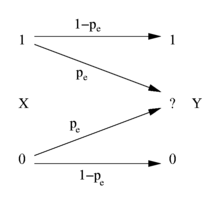Binary erasure channel


A binary erasure channel (or BEC) is a common communications channel model used in coding theory and information theory. In this model, a transmitter sends a bit (a zero or a one), and the receiver either receives the bit or it receives a message that the bit was not received ("erased"). This channel is used frequently in information theory because it is one of the simplest channels to analyze. The BEC was introduced by Peter Elias of MIT in 1954 as a toy example.
Closely related to the binary erasure channel is the packet erasure channel which shares many similar theoretical results with the binary erasure channel.
Description
The BEC is a binary channel; that is, it can transmit only one of two symbols (usually called 0 and 1). (A non-binary channel would be capable of transmitting more than two symbols, possibly even an infinite number of choices.) The channel is not perfect and sometimes the bit gets "erased"; that is, the bit gets scrambled so the receiver has no idea what the bit was.
The BEC is, in a sense, error-free. Unlike the binary symmetric channel, when the receiver gets a bit, it is 100% certain that the bit is correct. The only confusion arises when the bit is erased.
This channel is often used by theorists because it is one of the simplest noisy channels to analyze. Many problems in communication theory can be reduced to a BEC.
Definition
A binary erasure channel with erasure probability p is a channel with binary input, ternary output, and probability of erasure p. That is, let X be the transmitted random variable with alphabet {0, 1}. Let Y be the received variable with alphabet {0, 1, e}, where e is the erasure symbol. Then, the channel is characterized by the conditional probabilities
- Pr( Y = 0 | X = 0) = 1-p
- Pr( Y = e | X = 0) = p
- Pr( Y = 1 | X = 0) = 0
- Pr( Y = 0 | X = 1) = 0
- Pr( Y = e | X = 1) = p
- Pr( Y = 1 | X = 1) = 1-p.
Capacity of the BEC
The capacity of a BEC is 1 - p.
Intuitively 1 - p can be seen to be an upper bound on the channel capacity. Suppose there is an omniscient "genie" that tells the source whenever a transmitted bit gets erased. There is nothing the source can do to avoid erasure, but it can fix them when they happen. For example, the source could repeatedly transmit a bit until it gets through. There is no need for X to code, as Y will simply ignore erasures, knowing that the next successfully received bit is the one that X intended to send. Therefore, having a genie allows us to achieve a rate of 1 - p on average. This additional information is not available normally and hence 1 - p is an upper bound.
Deletion channel
The binary erasure channel should not be confused with a deletion channel where bits from the transmitter are either transmitted to the receiver (with probability  ) or dropped without notifying the receiver (with probability
) or dropped without notifying the receiver (with probability  ). Determining the entropy of the deletion channel is an open problem.
). Determining the entropy of the deletion channel is an open problem.
See also
References
- David J. C. MacKay. Information Theory, Inference, and Learning Algorithms Cambridge: Cambridge University Press, 2003. ISBN 0-521-64298-1
- Thomas M. Cover, Joy A. Thomas. Elements of information theory, 1st Edition. New York: Wiley-Interscience, 1991. ISBN 0-471-06259-6.